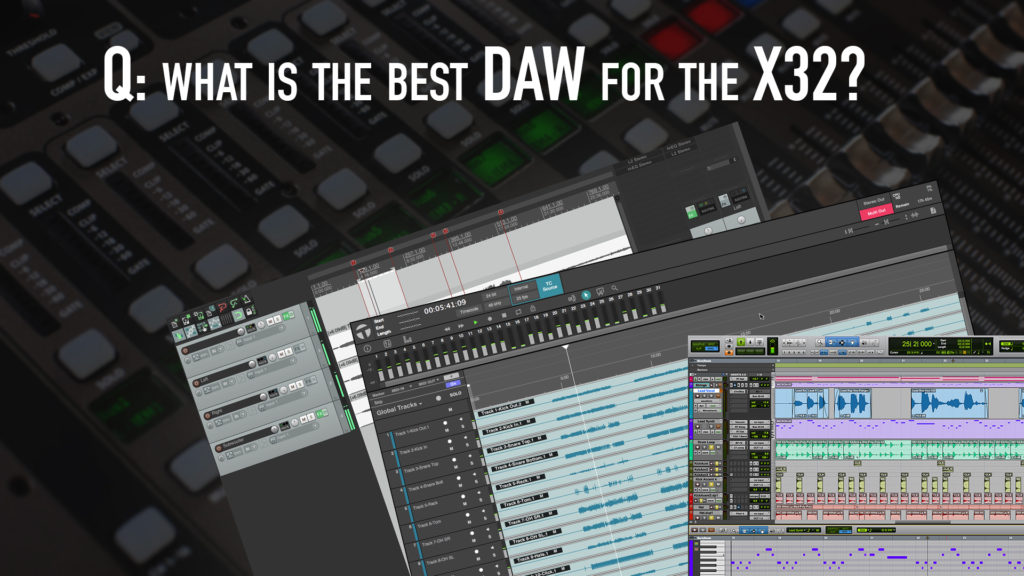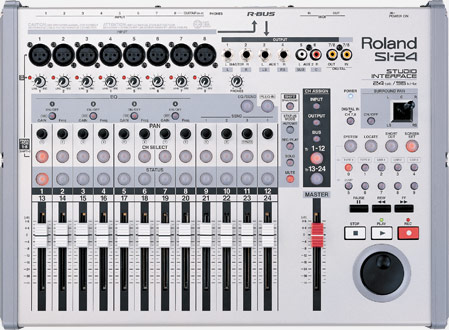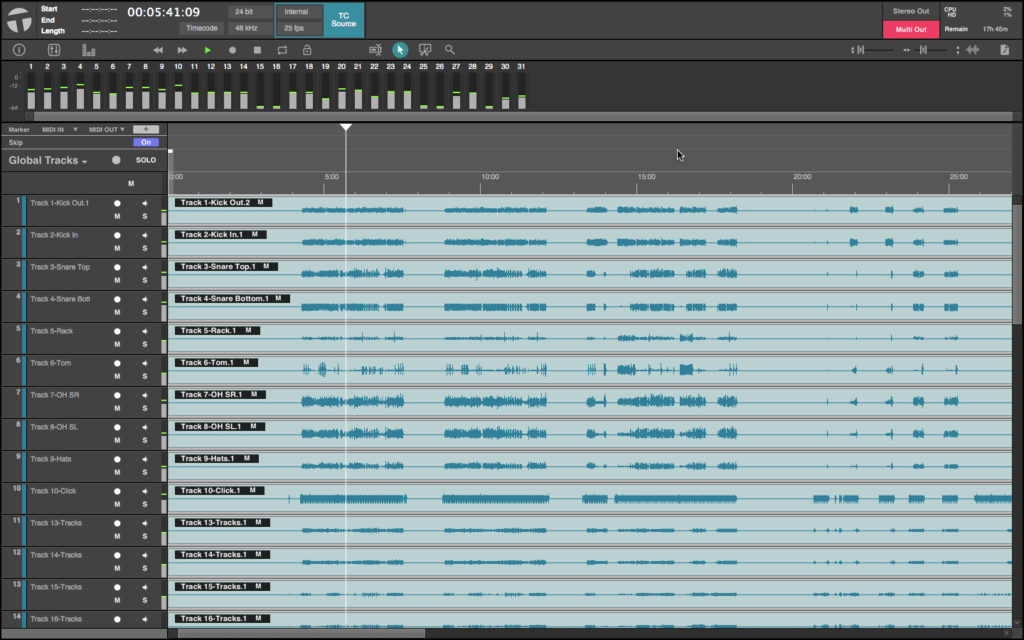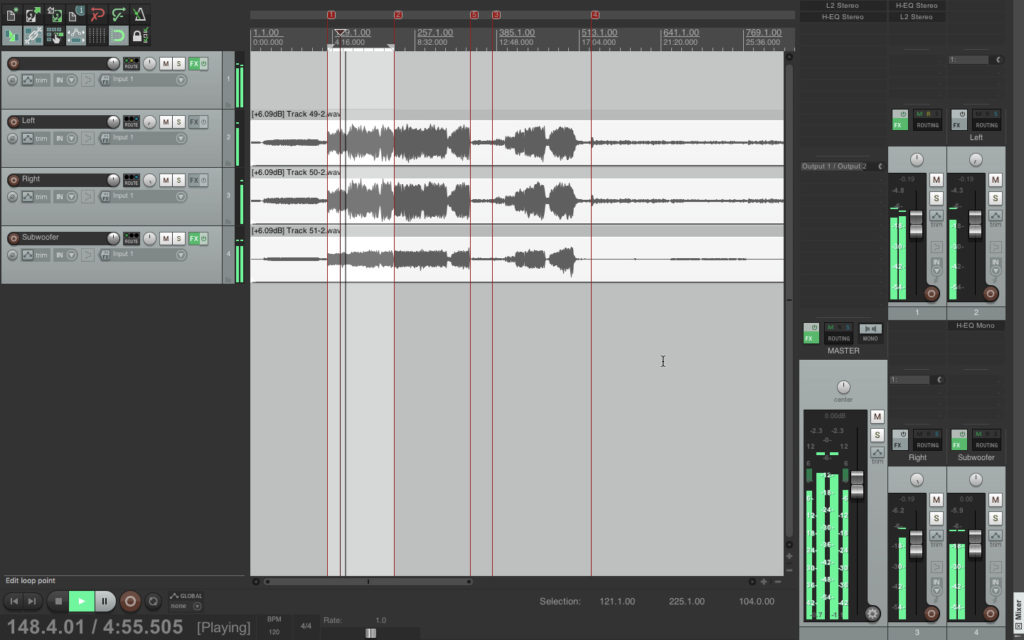Today, we’re starting out a series called ‘Your Questions’ which will be a collection of some of the most commonly asked questions that I receive, my favorite questions, or things I find that should prove helpful to those asking! First, let’s talk about DAW options.
Recently, Byron reached out and asked:
Drew,
What DAW would you recommend for use with X32 / M32?
I have been using PreSonus Studio One, but have not tried it with X32 / M32. Are there issues? Is there a preferred way to configure? PreSonus, of course, wants one to think their StudioLive consoles are the perfect DAW interfaces, but is there really any difference?
Thanks for any insights! All the best,
Best DAW for the X32/M32?
I receive this question (or some form of it) often! When I browse through forums and groups there are a LOT of differing opinions on this too. While you can use a free DAW, there are also more expensive pro-versions that take some getting used to if you haven’t been working with audio for that long – it all depends what you want to use it for and how much experience you have.
So, the answer is, there isn’t a ‘Best DAW’ for the X32/M32. It truly comes down to personal preference. Now granted, there are some bad DAW’s depending on what your use of it is.
If you are joining in and wondering, ‘What in the world is a DAW?’ I would be happy to clear that up for you! DAW stands for Digital Audio Workstation. On the most basic level, a DAW is a program that captures/records multi-channel audio and can play that audio back over multiple channels.
For a live audio engineer, this would provide the ability to record all of the channels of a show for use of ‘virtual soundcheck’ at a later time. For the recording audio engineer, this would be the main program they capture audio from their studio and then mix an album with it.
DAW’s
There are a ton of DAW’s available out there. I still remember using Cubase SE way back in the day with my Roland SI-24 and RPC-1 which was an 8 channel audio interface with 13 motorized faders. You had to manually set interrupts within the BIOS of the computer for the PCI card which would capture eight channels of up to two-way 24-bit/96kHz digital audio using a D-Sub cable.
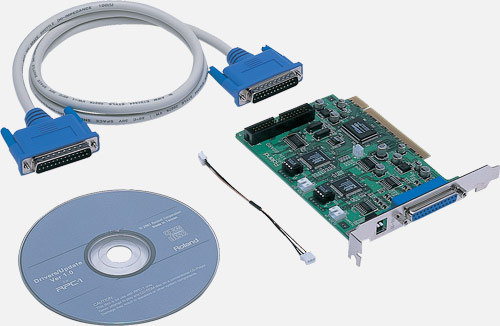 It was a MESS to set up but was really awesome to get recording back then.
It was a MESS to set up but was really awesome to get recording back then.
I look at how easy the X32 is to set up, and it is easy to laugh at what we had to go through only 15 years ago.
But, onto the DAW! Here is a list of the main DAW programs that are out there. In a bit, I will explain my main favorites.
- Ableton Live
- Acoustica Mixcraft Pro Studio
- Adobe Audition
- Apple Logic Pro
- Apple GarageBand
- Ardour
- Avid ProTools
- Audacity
- Bitwig Studio
- Cakewalk Sonar
- Cockos Reaper
- Image-Line FL Studio
- Magix Acid
- MOTU Digital Performer
- MuTools MuLab
- PreSonus Studio One
- Propellerhead Reason
- Renoise
- Steinberg Nuendo
- Steinberg Cubase
- Tracktion Software
- Waves Tracks Live
As you can see, there are several available, and I only listed 22! This list can honestly go on and on.
Audio Connections
Once you select your DAW, you need to get your audio interface set up. The audio interface is going to be the main audio input and output of your DAW. The higher quality audio interface you get in this location, the higher quality recordings you are going to produce.
In our case, the Behringer X32 or Midas M32 is going to be our audio console and we have the X-UF, X-USB, X-Live cards to select from to be our physical audio interface.
All three of these cards use USB as the main connection to your computer, so we need to connect up the USB cable from our computer to the card.
DRIVERS… DRIVERS… DRIVERS…
The ‘driver’ is the language for your computer to talk to the X-UF, X-USB, or X-Live card. If you have a Mac, you won’t need to worry about this section because the drivers (CoreAudio) are included with your computer already!
If you have a Windows or Linux machine, you won’t be as lucky and will need to track down and install the correct driver for your operating system and expansion card. This is one area where many people get stuck. Since there are so many configurations out there, Google will be your best friend in regards to specific driver problems. Be careful here as there are different drivers depending on if you have the X-UF, X-USB, or X-Live card! Lastly, make sure you are up to date on all updates for the firmware of the board as well as software updates for your computer.
Once you have drivers installed and working, then you are set and ready to go with using your interface for recording! The X32/M32 with the expansion card gets you 32 channels in and 32 channels out at the same time. This is pretty incredible and will let you multitrack record all of your 32 channels at the same time!
Favorite DAW’s
We are now at the controversial topic – my favorite DAW’s!
- Waves Tracks Live
- Reaper
- Avid ProTools
- Ableton Live
SIDE NOTE: This is not in a specific order, but all of these have a main function in my day to day job. I am a live sound engineer WAY more than I am a recording guy, and honestly, that is my preference at this point in my life. I would rather refer recording and mixing albums out to colleagues who are WAY more gifted in this area than I. I love the raw, untamed, and sometimes uncontrollable aspect of live sound. Having random problems arise and working through them to create a live production moving lots of energy through the air, that is what fuels me.
Waves Tracks Live
Because I’m a live sound guy, Waves Tracks Live is my main virtual sound checking tool. I will multitrack any of my live rehearsals or performances with this so that at a later time I can come back and practice, critique, or tweak the audio when the band isn’t on stage.
What I love about Tracks Live is that when you open the program, it asks you for the sound interface, then will calculate the maximum amount of channels the interface support. Tracks Live will then create that many channels (and depending on settings) can arm and start recording right away. It will route 1-1 2-2 3-3 on both the input and output side, with no needed input from me.
The beauty of this is how simple it is to get set up and working. It is fast and it always works. AKA one less thing I have to worry about! Lastly, the other great thing about this program is it is free!
Check it out! https://www.waves.com/mixers-racks/tracks-live
Also while you are at Waves, check out the plugins there! Make sure to click here to receive 10% off any of your Waves plugins! *This is an affiliate link
2022 Update: This is no longer supported and has not been updated for 64-bit only operating systems like the newer Mac OS software. If you have a computer that can run 32-bit software, then this is still one of my favorite DAW’s. Otherwise, check out Reaper as this is my 2nd favorite!
Reaper
Reaper is a great inexpensive DAW that is really powerful and simple to use. When I am mixing something down from a weekend or for an album, I will typically use Reaper as it is what I have always used!
There are a few different prices for individual/small business license or a commercial license. The other cool thing about Reaper is that the trial is a fully functional program during the trial period. So, you can fully test the program with no limitations to see if it is right for you.
Check it out! https://reaper.fm
Avid ProTools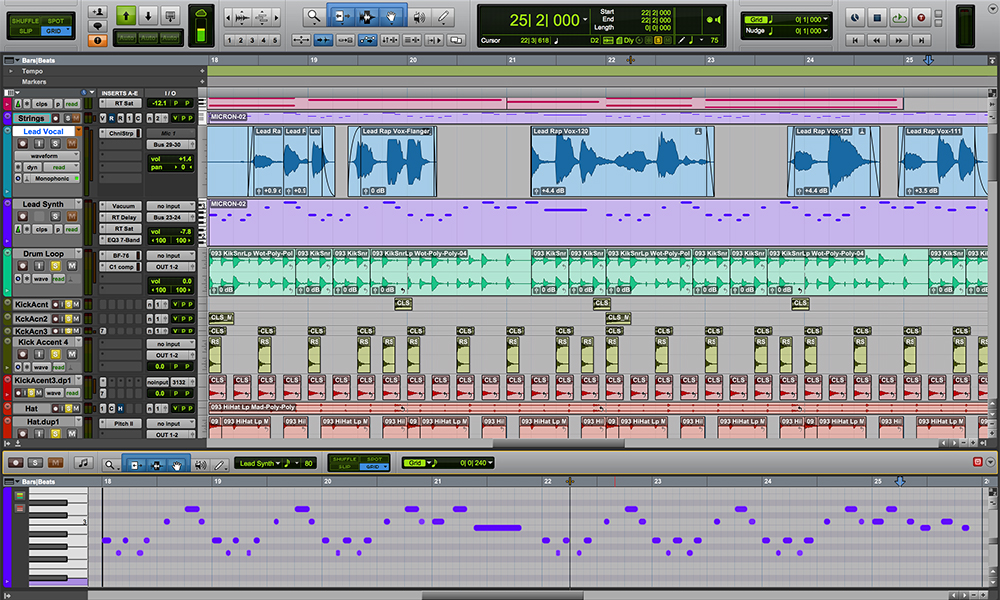
No list is complete without ProTools. It is the industry standard for DAW and has been around forever. Many recording guys I know use it and I haven’t seen a professional studio use anything other than ProTools.
But, I said I’m not a recording guy! Yes, this is true – however – I use the Avid VENUE series of consoles a LOT. Avid ProTools has a great function called ‘Venue Link’ that links the live console up with ProTools HD. Venue Link will automatically do all of the routing and copy all of the channel names into the separate tracks inside of ProTools. Not only that but when I recall a snapshot during a live show, it will mark when I recalled that snapshot. At a later time when I am doing virtual sound check, when I recall that snapshot on the console, it will automatically take ProTools to that specific spot in the recording.
The workflow of that alone is amazing and is a huge time saver for me.
Check it out! https://www.avid.com/pro-tools
Ableton Live
This program is a beast. Ableton is one of the most popular backing tracks programs out there. Most churches use this for their backing tracks and click track for the band to play along with supplementing the live instruments. There is a ton of functionality of this program and I couldn’t make a list without mentioning it!
Check it out! https://www.ableton.com/en/live/
Internal DAW?
If you are looking for a way to record audio from the Behringer X32 and play it back internally without the need for an external computer, you should check out the Behringer X-Live Expansion Card. This card allows you to record and playback 32 channels of audio on SD cards plugged directly into the X-Live card. I have a blog post about it here!
Wrapping Up
As you can see, there are a lot of different DAW’s out on the market. All of them bring a different flavor of functionality and workflow. To find your favorite, start downloading some and try them out! Next week we’ll be diving into that deep snare drum sound.
